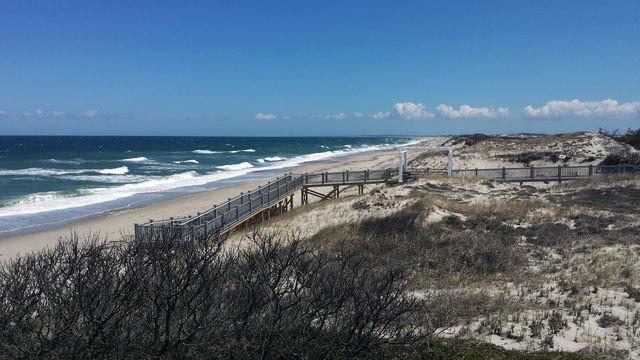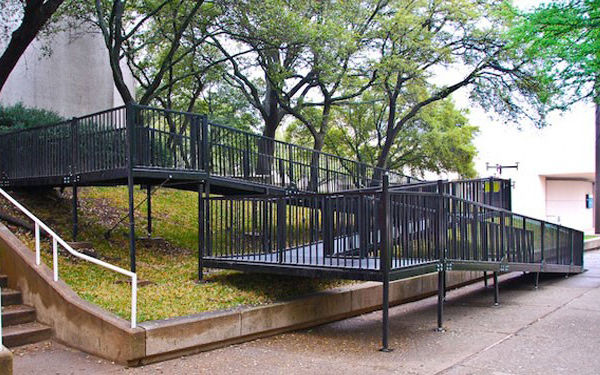


ADA-compliant residential boardwalk and ramp / Engineer: Coastal Engineering Company, Inc.
Providing access and inclusion, to accommodate people of all abilities, continues to be a challenging proposition with many previously developed spaces. In 2013, the United States Access Board drafted guidelines for federally developed projects to harmonize with the International Building Code and to follow up on the Americans with Disabilities Act (ADA) of 1990. The criteria developed from this process became mandatory in late 2013 and were incorporated into the Architectural Barriers Act (ABA) accessibility standards. Amenity areas covered by these access requirements include camping facilities, picnic facilities, viewing areas, trails, and beach access routes. The requirements were not limited to only federal lands, but also covered federally funded projects.
Criteria and ideals developed during this process are great for addressing new projects, but what about previously developed spaces and retrofitting access and infrastructure to conform to the new standards?
Upgrading previously developed projects to meet codes and regulations of new construction can be an arduous task and tough to achieve in retrofit projects. Site constraints, costs, available revenues, end user input, and key stakeholder input can influence programming and inform which existing facilities are or are not upgraded. Inclusion goals and providing ADA access to previously developed sites can also vary widely from one municipality to another, and one region to another.
One constant is that individuals with disabilities are well aware of which facilities were designed for inclusion and which ones have not been upgraded for ADA access, inclusion, and mobility.
ADA access requirements are not limited to just new development projects. Any upgrade to an existing facility needs to provide for ADA access where an exemption is not obtained. Historically registered structures and properties further complicate the retrofitting process because it may impact historical character and significance when proper ADA design is incorporated. Balance is key in providing modern ADA access while preserving features that can’t be replicated or have historical value. There is no one-size-fits-all solution because each project has different criteria, goals, and existing conditions. Creativity is needed to help a project be successful for all end users in addressing ADA requirements. When an out-of-the-box engineering solution doesn’t meet project goals, landscape architects are key in achieving creative and lasting ADA inclusion results.

Modular handicap ramp / image: Portawalk
Requirements to upgrade previously developed structures and projects for ADA access is not strictly limited to new construction or renovations. The Americans with Disabilities Act is a civil rights law, rather than a building code or development standard, meaning compliance can be tricky for existing facilities. Businesses and non-profit organizations accessed by the public at large are required to remove architectural barriers, even when making no renovations or upgrades, when it is “readily achievable.” Readily achievable, as defined by the ADA, is when barrier removal is “easily accomplishable and able to be carried out without much difficulty or expense.” Cost and constraints change over time and as working capital and other factors change; the ADA’s “readily achievable” requirements for a given project can change as well.
The goal is to use inclusive design to accommodate individuals with disabilities and to encourage a society that listens and responds to these individuals. From wheelchair-accessible swimming pools, to ADA ramps providing ocean access and wheelchair-based theme parks, people with disabilities cherish these offerings and feel more seamlessly integrated into society when their needs are considered. This is where landscape architects can provide the expertise, creativity, and problem solving skills to achieve desirable outcomes.
With any upgrade or retrofit project, it is key for designers and planners to spend ample time planning for and implementing ADA compliance to understand the cost and effects to the overall budget. Construction costs to provide for ADA access and compliance can be up to 20% of the overall retrofit construction budget, so proper planning and management of ADA criteria is essential to achieve final goals and objectives. The ADA National Network has developed a detailed checklist to assist in the planning and implementation of ADA upgrades to existing facilities. The checklist provides a wealth of knowledge for designers and planners, covering topics from access to goods and services to upgrading toilets and bathroom facilities.
The more our existing public facilities and key areas of public access can accommodate all end users, the more inclusive our society becomes. The hallmark of an industrialized nation is providing for all citizens. Upgrading ADA access, whether it is a retrofit/upgrade or under the “readily achievable” provision, is a critically important topic for today and in the future. Close to 50 million Americans have a disability. Ignoring or not significantly providing for 20% of the US population through design programming is a mistake we as designers cannot overlook.
This article is written by Nate Lowry, ASLA, a licensed landscape architect for MacKay Sposito in Federal Way, WA. He has 16 years of experience predominantly in the Puget Sound area. He is also a City Council member and member of the Pierce County Regional Council planning body. This article was originally published in ASLA Professional Practice Networks Blog.
Please contact us to learn more about professional civil and structural engineering services!